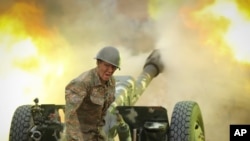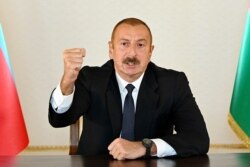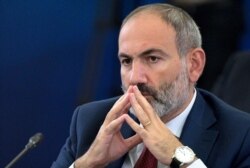Armenia and Azerbaijan traded accusations Tuesday of firing on each other across a shared border, the latest sign of a conflict over the breakaway region of Nagorno-Karabakh that is threatening to erupt into war.
Both countries reported firing to the west of the region, where intense fighting broke out Sunday between ethnic Armenian and Azeri forces, killing dozens of people and wounding hundreds of others.
Speaking on Russian state television, Azerbaijan President Ilham Aliyev and Armenian Prime Minister Nikol Pashinyan both rejected the possibility of talks, despite urgent appeals from Russia and the United States to end the violence.
The United Nations Security Council is expected to discuss the escalating fighting in the breakaway region of Nagorno-Karabakh later Tuesday.
The closed-door meeting was requested by five European nations — Britain, Belgium, Estonia, France and Germany — as the fighting intensified Monday between forces of Armenia and Azerbaijan in the enclave.
A spokesman for U.N. Secretary-General Antonio Guterres spoke to both Aliyev and Pashinian and called for “an immediate stop to the fighting, a de-escalation of tension and a return to meaningful negotiations without preconditions or delay,” according to the Associated Press.
The United States had called on Sunday for the hostilities to end. State Department spokeswoman Morgan Ortagus issued a statement saying the U.S. “condemns in the strongest terms this escalation of violence.” The statement urged both sides to work with the OSCE Minsk Group co-chairs “to return to substantive negotiations as soon as possible.”
The OSCE is the Organization for Security and Cooperation in Europe. The OSCE Minsk Group is tasked with finding a peaceful solution to the conflict.
The U.S., France and Russia co-chair the OSCE Minsk Group, which issued a joint statement Sunday concerning the “large scale military actions along the Line of Contact in the Nagorno-Karabakh conflict zone.”
“We strongly condemn the use of force and regret the senseless loss of life, including civilians,” the co-chairs said. They appealed “to the sides to cease hostilities immediately and to resume negotiations to find a sustainable resolution of the conflict.”
They called on the parties in conflict to take “necessary measures to stabilize the situation on the ground,” adding that there is no alternative to a peaceful negotiated solution of the conflict.
Armenia and Azerbaijan declared martial law and troop mobilizations on Sunday amid fighting over Nagorno-Karabakh.
Nagorno-Karabakh is within Azerbaijan’s borders but is governed by ethnic Armenians and supported by the Armenian government. The enclave seceded from Azerbaijan during the Nagorno-Karabakh War that ended in 1994 but has not been recognized by any country as an independent republic.
A war between the two former Soviet republics could also involve regional powers Turkey and Russia, which has a defense agreement with Armenia. The Turkish government supports its own ethnic Turkic kin in Azerbaijan.











